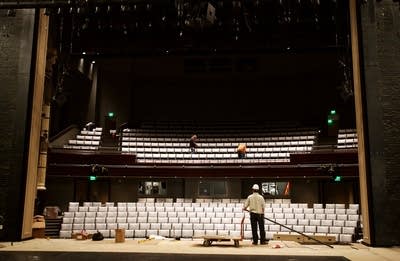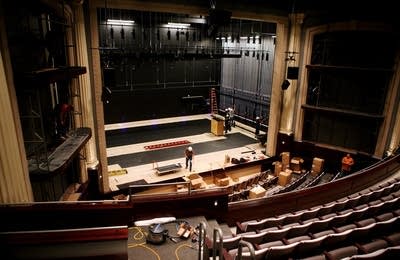Cowles Center is Twin Cities' new 'world-class' home for dance

A mixture of elation, disbelief and doubt from members of the Twin Cities dance scene will greet the opening of the $42 million Cowles Center for Dance and the Performing Arts Friday night in downtown Minneapolis.
Frank Sonntag, the executive director of the Cowles Center, was giving longtime Minnesota Dance Theatre instructor Lirena Branitski a tour on a recent day — and she could barely contain herself.
"I have a goosebumps ... that's my expression," Branitski said with a laugh. Sonntag came to the Cowles Center in February after managing the Brooklyn Center for the Performing Arts in New York. Already he's beginning to get a handle on how Minnesotans like to distance themselves from something that seems too good to be true.
FILLING A GAP
Create a More Connected Minnesota
MPR News is your trusted resource for the news you need. With your support, MPR News brings accessible, courageous journalism and authentic conversation to everyone - free of paywalls and barriers. Your gift makes a difference.
He also understands how dance artists are innately skeptical, given how their art form has historically been underfunded, under-appreciated and not understood by audiences. But Sonntag is supremely confident the new complex will lift the local dance scene to new heights, if only because it addresses the one major deficiency that's plagued it for years.
"There's not a building that people point to and say 'That's where they dance,'" he said. "But now there will be."
Sonntag isn't just referring to the refurbished former Shubert Theater, now named the Goodale Theater after Bob and Kathy Goodale, one of the center's three "founding families." There's also a bright, airy atrium and high-tech dance education studio on the second floor which connects the theater to the masonic bulwark on the corner, the Hennepin Center for the Arts. But it's the Goodale Theater that will probably inspire the most shock and awe this weekend.
The stage is an amazing expanse, 45-feet from the main curtain to the back wall, 89-feet from side to side. When some performers asked to have the dance floor made a "little softer" as they put it, Sonntag promptly had it fine tuned.
"It means we'll probably have to replace it in 25 rather than 30 years but in the meantime those dancers will be leaping a little higher and there will be fewer injuries and, you know, that's important," he said.
"Every aspect of this facility was designed with dance in mind."
Sonntag enjoys standing on the stage and taking in the majesty of this completely renovated turn-of-the-century theater. Four massive Greek columns are embedded in the walls on either side, reminders of the theater's storied history. There are also sections of exposed brick, remnants of the original structure. Below is a state of the art orchestra pit that can accommodate up to 42 musicians. Behind and above, a cavernous fly space that rises more than 100 feet.
"Those things are what is going to make this a world-class home for dance," he said. "Every aspect of this facility was designed with dance in mind. And dance is not the only thing that we will do, but it will be, predominantly what we do."
What will clinch the deal for audiences, Sonntag said, as he stares out at the theater's 500 seats, are the unsurpassed sightlines and intimacy.
"No seat is farther than 65 feet from the stage, and it's exceptional," he said.
A COMMITMENT TO AFFORDABILITY
Growing dance audiences and raising the level of dance are the two main goals of the Cowles Center. It's committed to keeping tickets, which will range between $18 and $36, relatively affordable.
Sonntag's plan also includes raising half of the Cowles Center's annual $2 million operating budget through donations from foundations, corporations and individuals. Then, he said, the Cowles Center won't have to pass on the burden of running the theater to the dance companies that perform there.
"The other thing that will help us grow the dance audience and will help the companies to succeed here is that we are bringing marketing muscle to the table that never existed," he said.
Sonntag said the Cowles Center will use media partnerships and a glossy new compendium of local dance groups to spread the word.
One woman who's always had complete faith in the Cowles Center's viability and future is Linda Andrews, artistic director of Zenon Dance Company. Andrews said the Cowles Center helps solidify Zenon's place in the dance community.
"For me, this is our home now," she said. This is our new home."
Andrews said the Cowles technical capabilities will allow Zenon's artistic vision to take flight.
"It has so much more depth in the stage than we're used to," she said. "We don't feel so constrained. And the lighting support, just the ability to be able to do more and more creative things with lights. That really really helps. And then just the orchestra pit — I mean the musical possibilities," she said.
Zenon, along with James Sewell Ballet and Minnesota Dance Theatre, are the three main resident companies at the Cowles Center. Its inaugural season will include 18 local dance groups, including the Minneapolis-based Indian classical dance company Ragamala Dance, which will premiere a new work later this month called "Sacred Earth." Ragamala co-artistic director Aparna Ramaswamy hopes the Cowles will take a strong curatorial role, programming the best the local dance scene has to offer.
"And then audiences can feel that the selection has been made for them, that all they have to do is attend," she said. "Audiences sometimes, they don't want to work too hard to understand dance. No one has time. So if the decision is made for them, I think it will be a lot easier."
A LONG-TERM PLAN
Hopes are high that the Cowles Center will have the same impact on dance that the Guthrie Theater had on regional theater when it was built in the early 1960s. Dance writer Caroline Palmer thinks that's possible, but not a guarantee.
"In the first few months, it'll be the new thing in town and that's very exciting," she said. "But on a long-term basis many more factors have to come into play."
The economy is Palmer's primary concern. She'll also be paying close attention to how audiences and performers experience the Cowles Center, to what extent the center's downtown location is a draw or a hindrance, and the degree to which the Cowles and the Twin Cities dance community can develop a symbiotic marketing strategy. Palmer said the Twin Cities dance scene, despite being recognized nationally as one of the strongest in the country, has been, to some extent, passed over by audiences.
"And this may be the piece that gets people to take another look at it, and to think 'Wow, maybe there's something I'm missing here in our arts community that's very valuable,'" she said.
People will be getting their first look at the Cowles Center this weekend. On Sunday the Cowles will open its doors to the community, with ongoing performances from a host of local companies. The Cowles will hold a black-tie, $1,000-ticket, gala celebration Friday and Saturday night. Two-hundred free tickets have been distributed to local dancers and choreographers, so they can revel in the magnificence of their new home.


